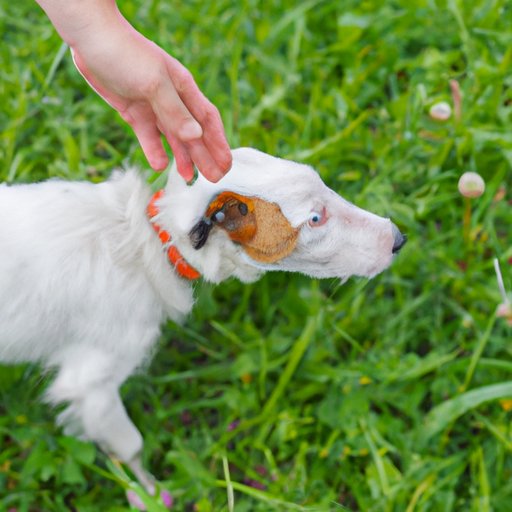I. Introduction
Tick removal is an essential part of responsible pet ownership. Ticks are blood-sucking parasites that can transmit dangerous diseases to both dogs and humans. These diseases can be debilitating and even fatal. Therefore, it’s important to know how to remove ticks quickly and safely from your dog’s skin to prevent the spread of diseases. This article serves as a comprehensive guide to help you remove ticks from your dog and prevent future infestations.
II. Step-by-Step Guide for Tick Removal
The following step-by-step guide will help you safely remove ticks from your dog:
A. Gathering necessary tools for the process
You’ll need a pair of fine-tipped tweezers, gloves, rubbing alcohol, and a container to hold the tick for proper disposal.
B. Identifying the type of tick
The type of tick affects the likelihood of your dog contracting specific tick-borne illnesses. Seek guidance from a veterinarian to correctly identify the type of tick.
C. Stabilizing the dog
Ensure your dog is secured before removal of the tick. Calming treats and face masks could help in calming the dog.
D. Removing the tick
Grasp the tick as close to your dog’s skin as possible with tweezers. Pull the tick straight up with steady, even pressure to avoid breaking the tick.
E. Disinfecting the bite area
Clean the bite area with rubbing alcohol or soap and water. This avoids infection of the site in case any part of the tick breaks and is left under the dog’s skin
F. Observing the dog for any symptoms of tick-borne illnesses
Monitor your dog for symptoms of tick-borne illness such as fatigue, fever, loss of appetite or sudden lethargy. If identified, seek medical assistance from a veterinarian.
III. Preventative Measures for Tick Infestations
Prevention is critical in avoiding a tick infestation on your dog’s skin. The following preventative measures are recommended:
A. The importance of tick prevention
Preventative actions could stop the spread of tick-borne illnesses to both humans and animals. A common phrase goes, “Prevention is better than cure.”
B. Using preventive products
Preventive measures include using tick repellents like insecticides and sprays to keep ticks away from your dog.
C. Conducting Regular Checks for your dog’s skin
Take time to regularly examine your dog’s skin. If you spot any ticks, it provides information on any parasitic presence on your dog’s skin.
D. How to handle tick infestation on a dog
If you identify several ticks infesting your dog’s skin, it is essential to seek medical attention from a veterinarian.
E. Actions to take after removing ticks from a dog
After removing ticks, clean and disinfect the area to avoid infections. It’s important to give your furry friend a treat to encourage positive behaviour.
IV. Natural remedies for Tick Removal
You might have an interest in alternatives to pharmaceutical products. Consider using natural remedies as a preventive method as well as an alternative to pharmaceutical products.
A. List of effective home remedies to remove ticks
Effective home remedies include using essential oils, coconut oil, garlic, and apple cider vinegar.
B. How to properly use each remedy
Get assistance from a certified veterinarian before using home remedies as a default mode of tick prevention. Some natural remedies might not be effective on all dogs.
C. Advantages of natural tick removal methods
The advantages include lower costs, fewer side effects when compared to insecticides and provide a natural approach to managing tick infestations
D. Things to consider before using natural remedies
The concentration of the organic compound needs to be correctly measured before use to avoid toxic effects. Essential oils should be diluted before use since full concentration can cause irritations.
V. Protection for you and your dog
Tick removal could carry potential risk. The following measures are essential in avoiding uneventful occurrences when removing ticks:
A. Safety measures for tick removal
Wear protective equipment like gloves and face masks when removing ticks from your dog.
B. Types of gloves and how to use them
Tear-resistant and disposable gloves are efficient materials to protect you from contamination by the tick.
C. The use of tweezers
Proper use of tweezers avoids accidental infection of the tick bite site or breaking the tick. Using the fine-tip section of the tweezers, you grasp the tick firmly and pull it out.
D. Proper handwashing techniques after a tick removal
Thorough handwashing after tick removal helps eliminate any bacteria, reducing risk of cross-contamination.
E. Advantages of using tick removers
Tick removers are more functional than forceps and require less force, hence reducing the chance of tearing the tick or breaking it.
VI. Understanding the Risks and Precautions
These are some of the risks associated with Tick bites that you need to be aware of to protect your pet and yourself:
A. Various risks associated with tick bites
Ticks can spread diseases such as Lyme disease and Rocky Mountain spotted fever to humans and their pets.
B. Diseases and conditions ticks can transmit to dogs
Dogs could contract tick-borne diseases such as Lyme disease, babesiosis, and hepatozoonosis.
C. Importance of seeking medical attention
Seeking medical attention immediately after discovering symptoms is critical in managing tick-borne illnesses.
D. The value of tick prevention
Preventing tick infestations on your dog from within the comforts of your home could save you large medical bills.
VII.Conclusion
Tick removal is a fundamental part in ensuring your dog’s safety and your well-being. You should follow the outlined guide to remove ticks effectively and safely from your furry friend. Regular preventive measures and cleanliness go a long way in avoiding tick infestations. For future tick infestations, you should consult a vet for guidance. Practice tick prevention measures within the budget, and let us all stay safe.
